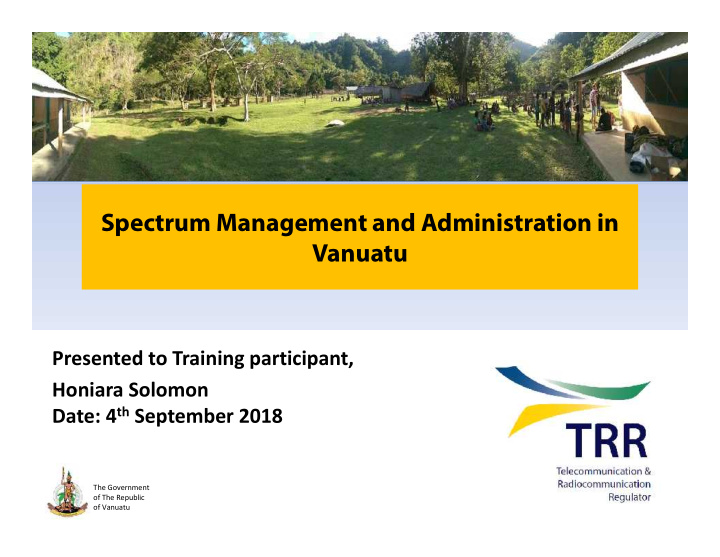



Spectrum Management and Administration in Vanuatu Presented to Training participant, Honiara Solomon Date: 4 th September 2018 The Government of The Republic of Vanuatu
Vanuatu – Geopolitical Overview Archipelago consisting of 83 islands of which 63 are inhabited Population of approximately 272,500 (July 2017 mini census estimates) 40% of the population are under 15 75% of the population live in rural areas GDP (2015) of $US767.4 million Largest contributor to GDP is Services (tourism) Agriculture follows close behind GNI per capita (2014) $US3,140 5% of monthly income is $US13 Cheapest unlimited fixed internet service is $US58 (512kbps) 1.5Gb monthly prepaid mobile (3G/4G+) data is $US8.95 Challenges Political stability, economic development, natural disasters, high cost of logistics (transport and shipping), ICT literacy
Legal Framework The Vanuatu Government, through the Telecommunications and Radiocommunications Regulations Act, No 30 of 2009 , established a separate and independent legal regulatory body, under the name: “Telecommunications and Radiocommunications Regulator (TRR) that provides for a regulatory framework for telecommunications and radiocommunications in Vanuatu. Legislation that mandates TRR to managed the spectrum are; The Telecommunications and Radio Communications Regulation Act No. 30 of 2009; Spectrum fees and Radio Apparatus License Fee regulation Order No. 157 of 2012; Telecommunication Licence; Also policies on; Spectrum and Apparatus licences and fees The Regulator has in place policies and guidelines on band planning for; Fixed services IMT services
Competitive Landscape TRR is an Independent Regulator Two full service carriers (Telecom Vanuatu, Digicel) Significant microwave backhaul and spur infrastructure Minimal use of satellite Both use licenced and unlicenced spectrum A further 4 ISP players Telsat – WISP (unlicensed spectrum), HTS VSAT (Kacific) Wantok – WISP (fixed 4G licenced and unlicenced spectrum), HTS VSAT (Kacific) SPIM – Wireless hotspots (unlicenced spectrum) PGL – HTS VSAT (Kacific) Single Submarine Cable – Interchange Cable Limited Fiji – Vanuatu Second cable in planning phase (RFS estimated late 2019 early 2020) Planned route: Port Vila – Luganville - Honiara
Some Statistics
National Spectrum Management TRR issues licenses authorizing a person to Provide telecommunications services to end users to and from anywhere in Vanuatu; Operate radiocommunication devices; and Use radio spectrum. 3 types of licenses Spectrum License Radio Apparatus Licence General User Radio Licence (GURL)
IMT Spectrum Bands Spectrum for IMT is used for 2G, 3G and 4G+ services Spectrum licences are renewed yearly Bands could be used for 5G services – technology neutral approach Current IMT spectrum bands in use APT700Mhz Assigned with spare capacity but not utilised 900MHz Fully assigned 1800MHz Fully assigned 2100MHz Assigned with spare capacity Future bands to be investigated 800MHz (APT review and PPDR) 2300, 2400, and 3.2GHz (currently all WiMAX but little use) WRC19 identified bands
Current Spectrum Pricing IMT Bands APT700MHz (90,000 VT per MHz) 900MHz (90,000 VT per MHz) 1800MHz (50,000 VT per MHz) 2100MHz (27,000 VT per MHz) WiMax Bands 2.3 GHz (17,000 VT per MHz) 2.5 GHz (22,500 VT per MHz) 3.5 GHz (15,000 VT per MHz) Digital TV bands 500 – 690 MHz (6,750 VT per MHz) Radio Apparatus Licence Aeronautical, Maritime, Amateur, Fixed, Land Mobile etc.. Approved fees are charge per Radio Apparatus Device
Future 5G Spectrum Vanuatu is currently investigating the planning for those bands to be allocated Likely to remain unassigned in the short to medium term Spectrum under consideration is inline with current APT recommendations to be proposed at WRC19 There does not appear to be any significant rationale to not proceed with the ITU recommended spectrum bands Current demand scenarios are low Unlikely that there will be any rapid uptake of 5G services in Vanuatu in the short term
Satellite Spectrum Little use of C-band FSS Both full service operators have C-band dishes but have effectively turned these off in favor of cable Can be used in backup situations if required Some C-band in use by USP, but declining Increasing use of Ku/Ka VSAT FSS Kacific HTS services are used across the country Provide coverage into remote and rural areas Consideration of use for remote IMT backhaul (ie share the infrastructure) Other satellite services/spectrum in use Meteorological TVRO (Television Receive Only) Maritime services (GMDSS) Portable BGAN services Handheld iridium
The Future Challenges for Spectrum Management Continue to use tools available ITU SMS4DC – key to spectrum management APT AFIS – for public information on spectrum holdings Better management of microwave fixed links Licensees have had free range on spectrum SMS4DC is starting to bring this into control Continued need to approach Licensees for information on new and defunct links Shared Spectrum How to share efficiently and effectively without Licensee complaints. Desire to reduce cost to Licensee Spectrum Pricing Comments of high licence fees Licensing models appear to be overly complex and need to be simplified Some model elements are not able to be identified Alternative Spectrum TVWS and its use for broadband
Tankyu Tumas
Recommend
More recommend